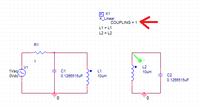SK245230
Member level 3
I have readed in many articles that for high coupled inductors (high k) you get a better efficiency using non-resonant inductive link. On the other side, for low coupled inductors (low k) you get a better efficiency using a resonant inductive link.
So I wanted to check this information through a simulation on LTSpice. Below you have two designs, one resonant and one non-resonant designed for 100kHZ.

I have simulated the efficiency for high k=0.8, blue curve=resonant, yellow=non-resonant

For low k=0.1

As expected at low k, you get a better efficiency for non-resonant. But for high k, non-resonant has almost the same efficiency as resonant.
Is it normal or am I missing something in my model? Why do we use only non-resonant inductive link for high coupled inductors?
So I wanted to check this information through a simulation on LTSpice. Below you have two designs, one resonant and one non-resonant designed for 100kHZ.

I have simulated the efficiency for high k=0.8, blue curve=resonant, yellow=non-resonant
For low k=0.1
As expected at low k, you get a better efficiency for non-resonant. But for high k, non-resonant has almost the same efficiency as resonant.
Is it normal or am I missing something in my model? Why do we use only non-resonant inductive link for high coupled inductors?

